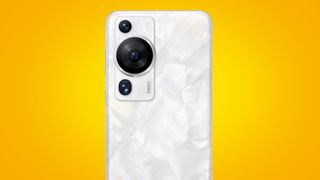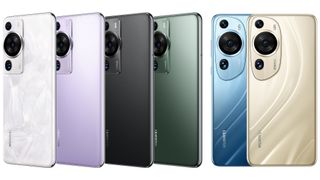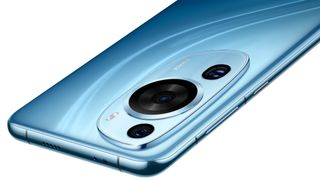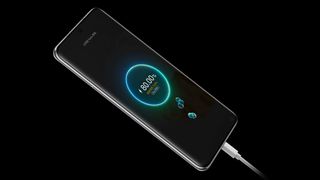Huawei P60: everything you need to know
Huawei's next flagship phones have arrived

In many ways, Huawei is one of the most exciting and accomplished smartphone makers on Earth. As such, its new flagships are always worth paying attention to, and the Huawei P60 series has now officially broken cover in the UK, Europe and China.
The new flagship line consists of the standard Huawei P60, along with the Huawei P60 Pro and – rather than an expected Huawei P60 Ultra or Huawei P60 Pro Plus – a top-tier model called the Huawei P60 Art. However, only the P60 Pro is available in Western markets, with the other two models reserved for China.
There might also be a more affordable Huawei P60E or P60 Lite coming down the pipeline, but no such device has yet materialized and we haven't heard anything about its existence. Below, then, you’ll find everything you need to know about the Huawei P60 series, including the line's release date, price, and specs.
The entire Huawei P60 series launched in China on March 23, before the P60 Pro went on sale in the UK and Europe on May 9.
Cut to the chase
- What is it? Huawei's latest flagship phone series
- When is it out? March 23 in China, May 9 in the UK and Europe (for the Pro)
- How much does it cost? From £1,199.99 for the P60 Pro
Huawei P60: release date and price

Let's start with UK and European pricing for the Huawei P60 Pro, which went on sale at Huawei on May 9, 2023 in two storage configurations:
- 8GB RAM/256GB: £1199.99 / €1199
- 12GB RAM/512GB: £1299.99 / €1399
Incidentally, Huawei says that anyone purchasing the P60 Pro from the UK Huawei store by June 5 will also be rewarded with a free Huawei Watch GT 3. Customers purchasing the 512GB storage variant (also by June 5) can claim an additional £100 voucher which can be redeemed on the UK Huawei store.
It's worth noting, though, that the 8GB/256GB variant of the P60 Pro is only available in black, while the larger 12GB/512GB variant is only be available in Rococo Pearl.
Below, we've highlighted Chinese pricing for the rest of the Huawei P60 series.
Get daily insight, inspiration and deals in your inbox
Get the hottest deals available in your inbox plus news, reviews, opinion, analysis and more from the TechRadar team.
Huawei P60
- 128GB = CNY¥4,488 (approximately $660 / £535 / AU$980)
- 256GB = CNY¥4,988 (approximately $730 / £595 / AU$1,090)
- 512GB = CNY¥5,988 (approximately $880 / £715 / AU$1,305)
Huawei P60 Pro
- 256GB = CNY¥6,988 (approximately $1,025 / £830 / AU$1,525)
- 512GB = CNY¥7,988 (approximately $1,170 / £950 / AU$1,745)
Huawei P60 Art
- 512GB = CNY¥8,988 (approximately $1,315 / £1,070 / AU$1,960)
- 1TB = CNY¥10,988 (approximately $1,610 / £1,310 / AU$2,400)
It should go without saying at this point that these phones won’t land in the US and there’s a high chance that they won't make it to Australia, either.
Huawei P60: design and display
As it turns out, the leaks and interpretative renders that we saw in the lead-up to the P60 series' reveal look to have been right on the money.
All three phones share a near-identical design, centered around a 6.67-inch 1220 x 2700 LTPO OLED display with an adaptive refresh rate which can scale from 1Hz to 120Hz (with a 300Hz touch response rate and 1440Hz PWM dimming for reduced eye fatigue) and an in-display optical fingerprint sensor.
The most notable design element across all versions of the P60 is unquestionably its camera array, with a large central element playing host to the phone's primary 48MP sensor (true across all models), while an ultrawide and periscopic telephoto sensor lie offset on the camera bump above and below. It's not a sensor arrangement we've seen before and should make the P60 series instantly recognisable, even at a distance.

As for the rest of the hardware, the IP68-certified bodywork consists of a four-way curved-edge front, covered in the same toughened KunLun glass that Huawei introduced on the Mate 50 Pro, last year (at least on the P60 Pro and Art). Meanwhile, a polished, color-matched metal frame and a glass back.
Speaking of color, the P60 and P60 Pro come in a choice of four: Rococo Pearl, violet, black and green, with the white finish being particularly eye-catching, resembling the white nacre on the inside of an oyster's shell. The P60 Art boasts a bespoke finish all its own, in either Azure Blue or Seashore Gold, with a more organic-looking camera bump to boot.
Huawei P60: camera and battery

The Dual Matrix camera design of the P50 series is gone and in its place is that new discreet triple rear sensor setup. Across all three models of P60, you get the same 48MP primary RYYB-arrangement sensor (a favorite of Huawei's, that this time promises increased light sensitivity), supported by OIS (optical image stabilization). Like the Mate 50 Pro, it also boasts a physical ten-speed variable aperture, which can step up to f/4.0 and all the way down to an impressive f/1.4.
In the case of the P60, the XMAGE camera system also includes a 13MP f/2.2 ultrawide and a 12MP f/3.4 5x optical zoom periscope telephoto lens that tops out at 50x magnification. Meanwhile, the P60 Pro and P60 Art both trade up to a superior 48MP optically-stabilized 'night vision' periscope telephoto camera, with a significantly wider f/2.1 aperture that should enable far better telephoto zoomed shots in low light than practically any other phone out there, while also delivering a maximum 100x zoom range.
On the processing side, the company's XD Fusion Pro system has reportedly been gifted a new 'texture engine' to help restore lost detail in images, with examples like the facets of a light-backed crystal, the texture of a plant stems and the dark lines naturally set into materials like leather and metal.
Video capture tops out at 4K resolution, with up to 960fps Full HD slow motion recording (using AI interpolation), while a 13MP f/2.4 punch-hole front-facing camera persists across all versions of the P60 too.

The P60 and P60 Pro possess 4,815mAh lithium-polymer batteries, while the P60 Art boasts a larger a more energy-dense 5,100mAh silicon-oxide power source (a technology former bedfellow Honor introduced to the mobile market first with the Chinese launch of the Honor Magic 5 Pro, claiming 12.8% higher energy density compared to lithium-based alternatives). In essence, even if all three models packed in the same capacity battery, the P60 Art's cell should still last longer thanks to the newer, more advanced technology at play.
As for charging, while all three P60s make room for 50W wireless charging, it's the P60 Pro and P60 Art that again stand apart, with their 88W wired charging speeds (Huawei claims the P60 Pro can reach 50% charge after just ten minutes), while the standard P60 still delivers unquestionably-rapid 66W wired fast charging.
Huawei P60: specs and features
What's nice about the P60 series is that there isn't a huge amount of variation between the three tiers of devices in the lineup (they all share the same dimensions, display and chipset, for example), meaning you still get some of Huawei's best work to date, even if you opt for the base Huawei P60.
All three phones run on a 4G-only variant of Qualcomm's Snapdragon 8 Plus Gen 1 chipset from 2022 (no sign of a Snapdragon 8 Gen 2-powered Huawei phone just yet), just like the Mate 50 Pro and implying comparable performance to devices like the 5G-toting 8 Plus Gen 1-powered Samsung Galaxy Z Flip 4 or the latest Realme GT 3.
Here's the full spec breakdown across models:
| Huawei P60 | Huawei P60 Pro | Huawei P60 Art | |
|---|---|---|---|
| Dimensions: | 161 x 74.5 x 8.3mm | 161 x 74.5 x 8.3mm | 161 x 74.5 x 8.3mm |
| Weight: | 197 grams | 200 grams | 206 grams |
| Main display: | 6.67-inch (1220 x 2700) 120Hz LTPO OLED | 6.67-inch (1220 x 2700) 120Hz LTPO OLED, protected by KunLun Glass | 6.67-inch (1220 x 2700) 120Hz LTPO OLED, protected by KunLun Glass |
| Chipset: | Snapdragon 8 Plus Gen 1 4G | Snapdragon 8 Plus Gen 1 4G | Snapdragon 8 Plus Gen 1 4G |
| RAM: | 8GB | 8GB / 12GB | 12GB |
| Storage: | 128GB / 256GB / 512GB. Expandable via NM up to 256GB | 256GB / 512GB. Expandable via NM up to 256GB | 512GB / 1TB. Expandable via NM up to 256GB |
| OS: | HarmonyOS 3.1 (China), EMUI 13.1 (Global) | HarmonyOS 3.1 (China), EMUI 13.1 (Global) | HarmonyOS 3.1 (China), EMUI 13.1 (Global) |
| Primary camera: | 48MP, f/1.4 to f/4.0 w/ OIS | 48MP, f/1.4 to f/4.0 w/ OIS | 48MP, f/1.4 to f/4.0 w/ OIS |
| Ultrawide camera: | 13MP, f/2.2 | 13MP, f/2.2 | 13MP, f/2.2 |
| Telephoto camera: | 12MP, f/3.4 5x optical periscope zoom w/ OIS | 48MP, f/2.1 3.5x optical periscope zoom w/ OIS | 48MP, f/2.1 3.5x optical periscope zoom w/ OIS |
| Front camera: | 13MP, f/2.4 punch-hole | 13MP, f/2.4 punch-hole | 13MP, f/2.4 punch-hole |
| Battery: | 4,815mAh (lithium-polymer) | 4,815mAh (lithium-polymer) | 5,100mAh (silicon-carbon) |
| Charging: | 66W wired, 50W wireless | 88W wired, 50W wireless | 88W wired, 50W wireless |
| Colors: | Rococo Pearl, violet, black, green | Rococo Pearl, violet, black, green | Azure Blue, Seashore Gold |
Interestingly, HongMeng OS 3.1 is the the software experience users in China will encounter, but rather than HarmonyOS, Huawei's global website lists the international version of the P60 line as running on EMUI 13.1 (likely based on Android 13 but without the Google Play Store).
We reported back in September last year that Huawei actually managed to beat Apple to the punch with regards to bringing satellite connectivity to the Mate 50 series and that technology persists on the P60 line too, at least in China – with the system relying on the Chinese Beidou satellite network – to support what is now two-way satellite messaging.

Alex joined as TechRadar's Senior Phones Editor in June 2022, but brings over a decade's worth of experience to the role, with an expertise in smartphones, tablets and wearables. He's covered keynotes hosted by the biggest brands and attended the launches for some of the most influential mobile products of the last few years. His experience was amassed at some of the most reputable consumer technology publications out there, including GSMArena, TechAdvisor and Trusted Reviews.
- Axel MetzPhones Editor
